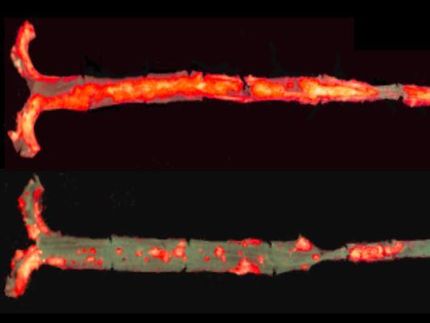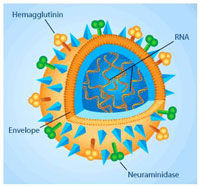Biodegradable particles can bypass mucus, release drugs over time
Johns Hopkins University researchers have created biodegradable nanosized particles that can easily slip through the body's sticky and viscous mucus secretions to deliver a sustained-release medication cargo. The researchers say these nanoparticles, which degrade over time into harmless components, could one day carry life-saving drugs to patients suffering from dozens of health conditions, including diseases of the eye, lung, gut or female reproductive tract.
The mucus-penetrating biodegradable nanoparticles were developed by an interdisciplinary team led by Justin Hanes, a professor of chemical and biomolecular engineering in the Whiting School of Engineering at Johns Hopkins. The team's work was reported in the Proceedings of the National Academy of Sciences . Hanes' collaborators included cystic fibrosis expert Pamela Zeitlin, a professor of pediatrics at the Johns Hopkins School of Medicine and director of pediatric pulmonary medicine at the Johns Hopkins Children's Center.
These nanoparticles, Zeitlin said, could be an ideal means of delivering drugs to people with cystic fibrosis, a disease that kills children and adults by altering the mucus barriers in the lung and gut. Beyond their potential applications for cystic fibrosis patients, the nanoparticles also could be used to help treat disorders such as lung and cervical cancer, and inflammation of the sinuses, eyes, lungs and gastrointestinal tract, said Benjamin C. Tang, lead author of the recent journal article and a postdoctoral fellow in the Department of Chemical and Biomolecular Engineering.
In the lungs, eyes, gastrointestinal tract and other areas, the human body produces layers of mucus to protect sensitive tissue. But an undesirable side effect is that these mucus barriers can also keep helpful medications away. In proof-of-concept experiments, previous research teams led by Hanes earlier demonstrated that latex particles coated with polyethylene glycol could slip past mucus coatings. But latex particles are not a practical material for delivering medication to human patients because they are not broken down by the body. In the new study, the researchers described how they took an important step forward in making new particles that biodegrade into harmless components while delivering their drug payload over time.
"The major advance here is that we were able make biodegradable nanoparticles that can rapidly penetrate thick and sticky mucus secretions, and that these particles can transport a wide range of therapeutic molecules, from small molecules such as chemotherapeutics and steroids to macromolecules such as proteins and nucleic acids," Hanes said. "Previously, we could not get these kinds of sustained-release treatments through the body's sticky mucus layers effectively."
The new biodegradable particles comprise two parts made of molecules routinely used in existing medications. An inner core, composed largely of polysebacic acid (PSA), traps therapeutic agents inside. A particularly dense outer coating of polyethylene glycol (PEG) molecules, which are linked to PSA, allows a particle to move through mucus nearly as easily as if it were moving through water and also permits the drug to remain in contact with affected tissues for an extended period of time.
In Hanes' previous studies with mucus-penetrating particles, latex particles could be effectively coated with PEG but could not release drugs or biodegrade. Unlike latex, however, PSA can degrade into naturally occurring molecules that are broken down and flushed away by the body through the kidney, for example. As the particles break down, the drugs loaded inside are released.
Polyethylene glycol acts as a shield to protect the particles from interacting with proteins in mucus that would cause them to be cleared before releasing their contents. In a related research report, the group showed that the particles can efficiently encapsulate several chemotherapeutics, and that a single dose of drug-loaded particles was able to limit tumor growth in a mouse model of lung cancer for up to 20 days.

























































